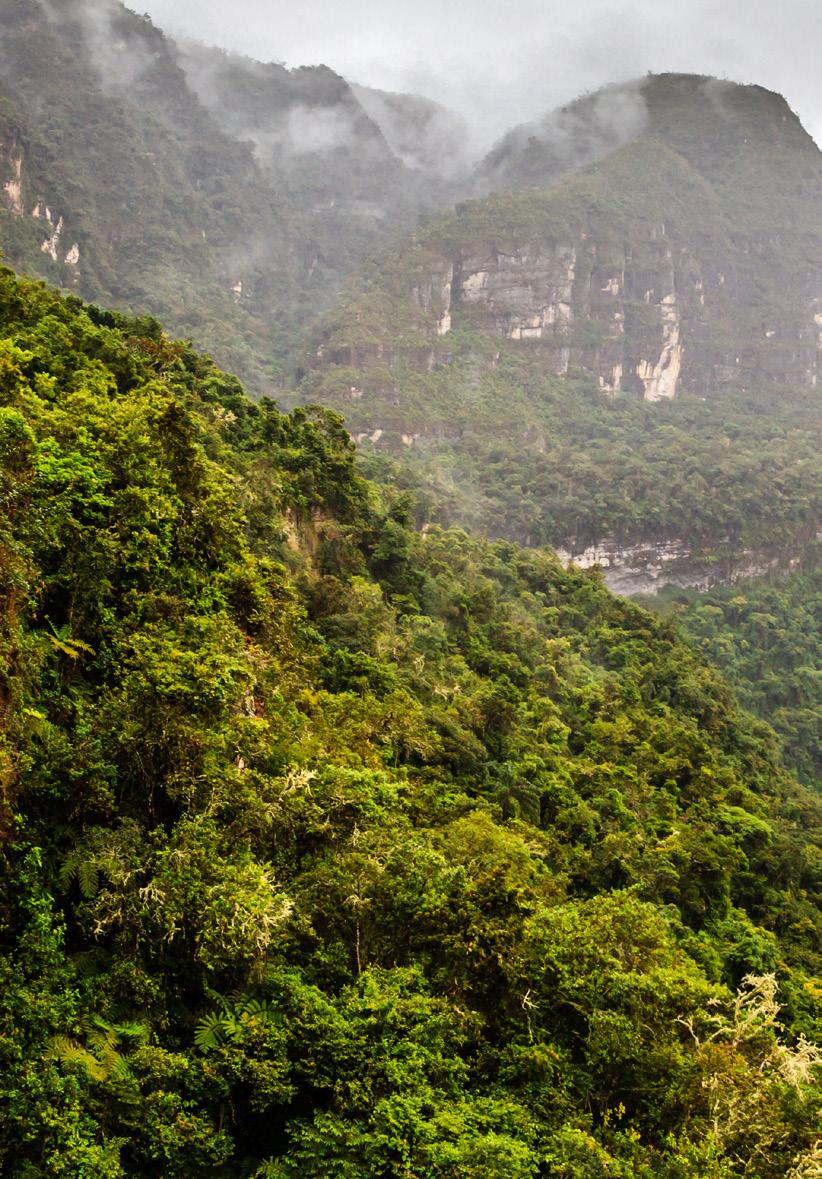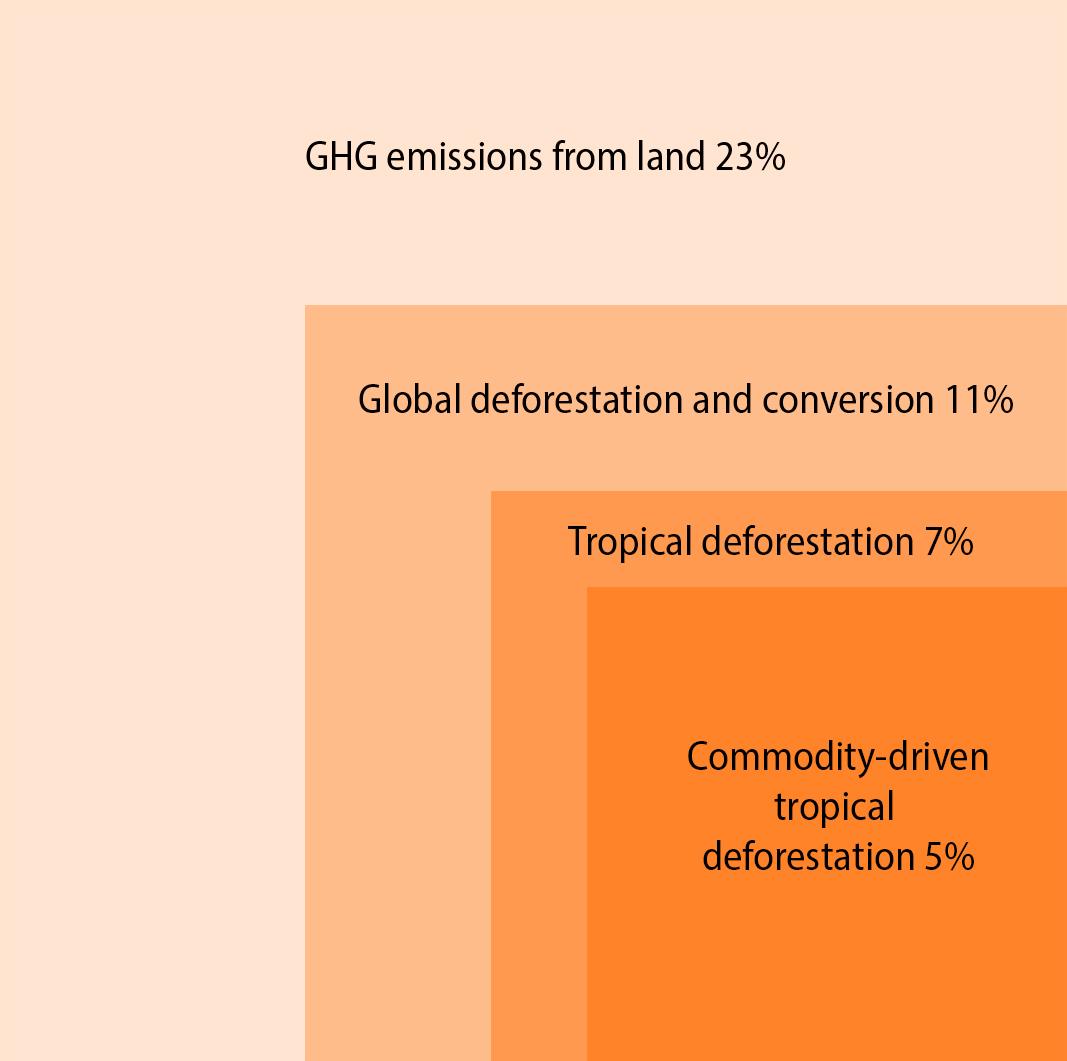
9 minute read
PART 1 Deforestation and its Effects on Climate Change
Introduction
As a major driver of climate change, global deforestation has significant financial implications for investors.
Advertisement
Even as the COVID-19 pandemic throttled the global economy, deforestation continued largely unchecked in many parts of the world. Every day, vast swaths of tropical forests are razed for production of agricultural commodities such as soybeans, palm oil and beef that eventually make their way to grocery shelves worldwide. Clearing and burning forests emits staggering amounts of greenhouse gases (GHGs) and reduces the land’s ability to store carbon. Protecting and restoring forests and other natural ecosystems are second only to eliminating fossil fuel use as a solution to climate change.
In addition to increasing investors’ exposure to the systemic risk of climate change, deforestation poses additional salient risks. It accelerates global biodiversity loss and disruption of local and global precipitation patterns – something Brazil’s Amazon region is already seeing with reduced rainfalls and shorter growing seasons. It also drives animals closer to human contact which can increase the occurrence of animal-borne infectious diseases.
Given these wide-ranging material impacts, investors should recognize and act on deforestation with the same vigor and urgency they bring to other drivers of climate change. Just as investors engage fossil fuel companies to reduce their carbon footprints, they should also engage companies in a wide range of industries that source agricultural and forest commodities – food and consumer products, auto components, textiles and apparel, among others – to eliminate deforestation from their commodity supply chains.
The stakes – and opportunities – are enormous. Companies that fail to reduce emissions from deforestation will face reduced market access, reputational risks, legal sanctions and other forms of financial exposure due to increasingly stringent policies, regulations and consumer expectations as the world shifts to a low-carbon global economy. Eliminating deforestation from supply chains is an achievable way to significantly reduce corporate greenhouse gas emissions and the systemic burden of climate change. Investors can use their influence as shareholders to engage with companies on deforestation as a way to mitigate portfolio-wide climate risks.
And now is the time. The Amazon is approaching a disastrous tipping point where vast areas of rich tropical forest are being transformed into degraded savannah and scrubland. Progress in limiting global temperature rise to 1.5 degrees Celsius – the goal of the Paris Climate Agreement – is behind schedule, and a huge shift in wide-ranging human activities is needed immediately. Eliminating deforestation is a linchpin of this shift. Simply put, we cannot avoid potentially catastrophic climate warming without eliminating deforestation.
This guide – the result of extensive input from investors and deforestation experts – gives investors a framework to help them understand and engage on deforestation-driven climate risks across their portfolios. It is especially intended for investors – in particular, engagement specialists – who are relatively new to deforestation and may be engaging on climate risk but not deforestation risk. The guide will help them understand the drivers of deforestation risk and prioritize company engagements based on industries, geographies and sourcing patterns. It also outlines key expectations that investors should be looking for in corporate climate and deforestation commitments and example questions for company and sector engagements. Lastly, the guide provides concrete next steps investors can take to address deforestation risk. 4
PART 1 Deforestation and its Effects on Climate Change

Human use of land has a unique role in climate change. Collectively, agriculture, forestry and other land uses are the second-largest source of greenhouse gas emissions behind the energy sector. At the same time, land is also the largest potential solution to climate change because of the twin opportunities to both reduce emissions from land use practices and remove additional carbon from the atmosphere by sequestering it in trees and soils. Lastly, land provides the basis for human livelihoods and well-being through food and freshwater supplies, climate and disease control and natural disaster mitigation. These ecosystem services are already compromised due to the effects of a 1 degree Celsius (1.8 Fahrenheit) rise in global temperatures and will be further undermined as temperatures continue to increase.1
To manage climate risk, investors have historically focused on sectors such as energy and industrials due to their significant contribution to GHG emissions from fossil fuel extraction and consumption. However, a growing number of investors are awakening to the large climate risk inherent in land use practices, and the even larger opportunity to mitigate climate change by changing them. There are many land-based climate solutions, but preventing destruction and degradation of forests and promoting forest restoration will have the largest impact in mitigating climate change.
GHG emissions from deforestation
Forests store large amounts of carbon in trees and soils. If the carbon in a single square kilometer of tropical forest was emitted as carbon dioxide (CO2) it would be equivalent to the CO2 emissions from the annual energy usage of 12,000 U.S. homes.2 When forests are converted to agriculture, mining or other land uses, felled trees are burned or left to decompose. The carbon in those trees is emitted mostly as CO2 and burning emits other GHGs such as nitrous oxide and methane. Carbon-rich forest soils are then plowed to plant crops or pastures, releasing even more GHGs into the atmosphere.
While maintaining healthy forests globally is critical to mitigating climate change, the majority of deforestation and most of the net GHG emissions from deforestation occur in the tropics. This is because tropical forests (1) currently face the highest pressure for large-scale conversion to agriculture and (2) store large amounts of carbon—much more than temperate forests.3
Tropical deforestation has a number of drivers. The largest share is due to forest clearance for agriculture and tree plantations. Tree plantations are human-planted forests that produce timber or wood pulp for paper, and often store less carbon than natural forests. A smaller proportion of tropical deforestation is due to mining, urbanization, energy infrastructure and natural forest fires. This guide focuses on GHG emissions from deforestation due to expansion of agriculture and forest commodities, which are the most likely to show up in the portfolios of institutional investors. This commodity-driven tropical deforestation is responsible for approximately 2.6 gigatons of CO2 emissions annually—or 5 percent of global GHG emissions.4
While the contribution of deforestation to GHG emissions has the largest and most direct impact on the climate, deforestation contributes to climate change in three other ways as well. First, deforestation not only releases carbon already stored in trees and soils, it also eliminates the future potential of the forest to sequester additional carbon. Intact tropical forests have absorbed a significant share of human-caused CO2 emissions in recent decades, though their future potential as carbon sinks is uncertain (see box on Loss of Forest Carbon Sinks below).5
Second, deforestation contributes indirectly to climate change by replacing a sink of GHGs with new GHG sources. Agricultural activities that replace forests emit additional GHGs such as methane from livestock and nitrous oxide from fertilizer use.
LOSS OF FOREST CARBON SINKS Tropical forests help sequester carbon emissions from human activity and thus for a long time have been considered an important carbon sink. However, recent scientific evidence indicates that the ability of tropical forests to sequester carbon in trees is in decline, potentially due to the impacts of drought and heat. The Amazon rainforest, for example, may cease to sequester additional carbon after 2040. Because of this shifting dynamic, climate change impacts in the tropics may be even more severe than predicted, adding to the imperative to preserve existing tropical forests.9 Third, forests shape local and continental climates by driving movements of air, water and heat through evaporation and transpiration. Deforestation alters these dynamics in ways that can dramatically impact temperature and precipitation both locally and thousands of miles away.6 For example, in parts of the Amazon, rainy seasons have been delayed by two weeks due to deforestation.7 Such changes can create feedback loops whereby drier conditions jeopardize the health of forests and cause fires—both natural and manmade—to spread out of control, emitting GHGs and further exacerbating deforestation.

UNDERSTANDING GHG EMISSIONS FROM LAND According to the 2019 IPCC Special Report on Climate Change and Land, 23 percent of global GHG emissions are from land. Of that, 11 percent of emissions are from deforestation and conversion of natural ecosystems to human uses. The remaining 12 percent are emissions directly from agricultural production such as livestock and fertilizers. Tropical deforestation contributes 7 percent of global GHG emissions,8 and most of that—5 percent of global GHG emissions—is driven by production of agricultural and forest commodities (Figure 1).
For definitions of terms used in this guide, please see the appendix.
Figure 1 GHG emissions from land

IT WILL NOT BE POSSIBLE TO LIMIT THE AVERAGE GLOBAL TEMPERATURE RISE TO 1.5° CELSIUS WITHOUT HALTING DEFORESTATION.
Eliminating commodity-driven tropical deforestation could reduce global annual GHG emissions by 5 percent.10 However, considering only emissions from deforestation underestimates the potential contribution of forests and other natural ecosystems to reduce greenhouse gases in the atmosphere. Restoring forests on previously deforested areas could sequester large amounts of carbon. Protecting and restoring other natural ecosystems such as grasslands, peatlands and coastal wetlands could also help mitigate climate change. Added together, protecting and restoring forests and other natural ecosystems could provide 16-30 percent of the climate change mitigation needed to limit global warming to 1.5-2 degrees Celsius—the goal of the Paris Climate Agreement.11 That’s nearly three-quarters the mitigation potential of all renewable energy technologies combined (Figure 2).
Avoiding catastrophic climate change will require reducing or sequestering a combined 1,580 gigatons of GHG emissions between 2020 and 2050 (Figure 2).12 To meet this challenge, we must deploy an entire suite of climate solutions: climate-smart agriculture practices that maintain soil carbon and reduce emissions from livestock and fertilizers; agroforestry systems that incorporate trees within croplands and grazing lands; solar and wind energy as primary electricity sources; improved energy efficiency in factories and office buildings; alternatives to and proper management of CFCs and HCFCs used as refrigerants; electrification of vehicle fleets and efficient low-carbon aviation and shipping; and technologies such as clean cookstoves for the three billion people who currently cook over wood and charcoal. But forests and other natural ecosystems are a large—and previously overlooked—part of the solution. When addressing climate risk in their portfolios, investors have an opportunity to elevate the role of forests and other natural ecosystems alongside solutions such as renewable energy that have historically been the focus of corporate and policymaker engagements.

Figure 2 Comparison of climate solutions in terms of their potential to reduce GHG emissions and sequester carbon between 2020 and 2050. Data are from Drawdown Review 2020, 13 which provides individual estimates for 78 climate solutions. Solutions are grouped here according to how investors might assess their portfolios for opportunities and elevate solutions in investor-company dialogues. Please refer to the companion website.








